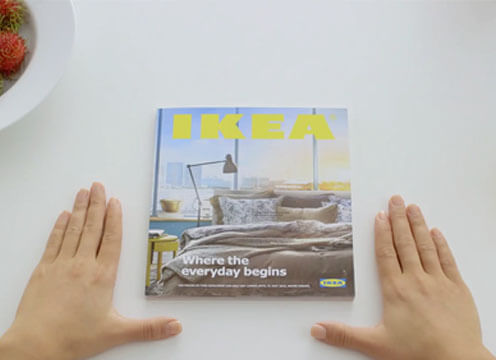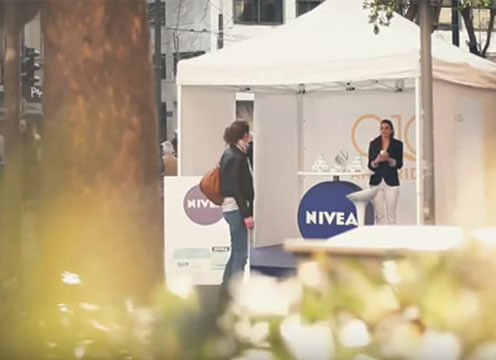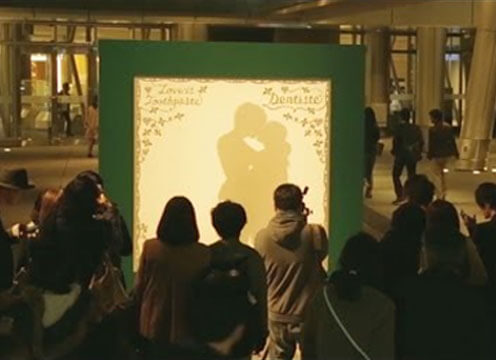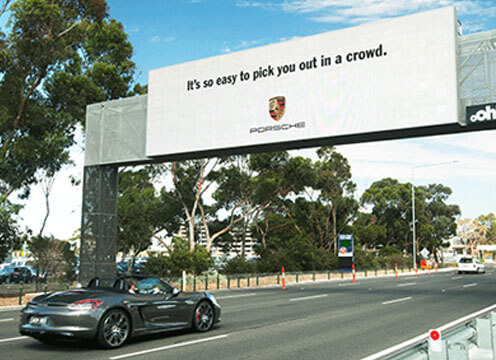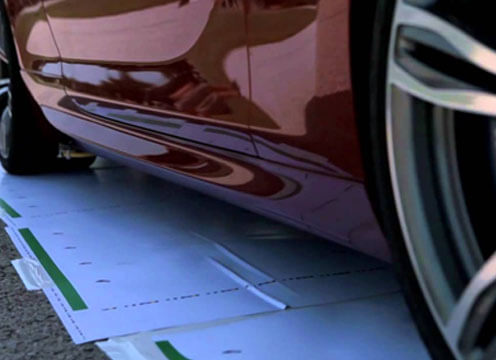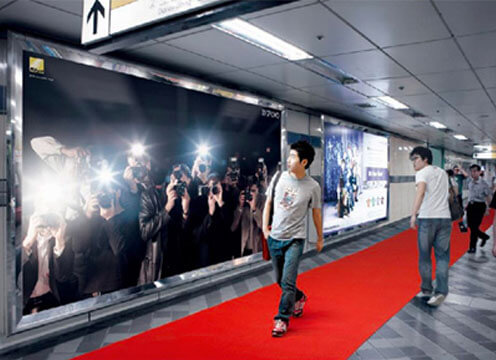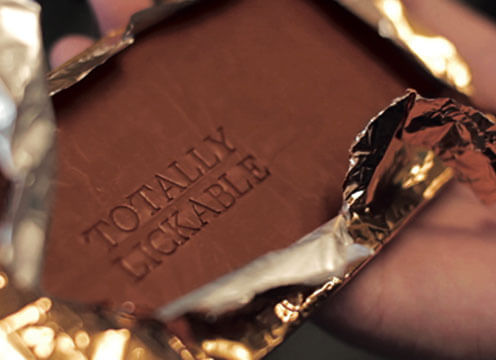| Back To Archives | |
| Home > Prints | Prev | Next |
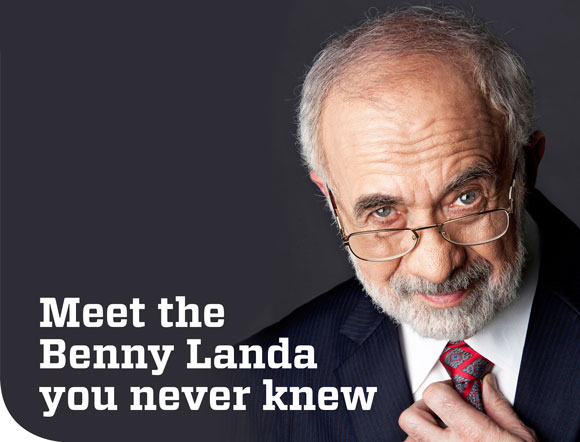
You’re likely familiar with Benzion (Benny) Landa as founder of the Indigo, the world’s first digital offset colour press which changed the course of the printing industry when it was unveiled almost 20 years ago at IPEX in Birmingham, England. What you may not know is that his fascinating odyssey began in the back of a small tobacco shop in Edmonton, Alberta. I found the story of his early years no less compelling than the remarkable technology he pioneered.
The year was 1946. Man finally made radar contact with the Moon. The UN General Assembly met for the first time. The CIA was established. Several countries such as Italy, Yugoslavia and Hungary became republics. Jackie (Roosevelt) Robinson played second base for the Montreal Royals a year before he broke baseball’s ‘colour barrier’ with the Brooklyn Dodgers. And, oh yes, the first bikini was sold in Paris, France. On the movie front, Frank Capra’s legendary film It’s a Wonderful Life premiered.
Well, Benny Landa’s wonderful life (and in hindsight it has been a remarkable journey thus far) began that same year when he was born in Wrotzlav, Poland. His father Oscar and mother Lottie had survived the Holocaust. They eventually fled Europe as post-war refugees, arriving in Edmonton, Alberta in 1948. “At that time, Edmonton was called the gateway to the Canadian North,” recalls Landa. “I found out how true that statement was during winters in Edmonton. It was sooooooooo cold,” he laughs.
 Landa spent his early formative years in a modest house at the corner of 95th Street and 104th Avenue in Edmonton’s East End with his brother Saul. Soon the entire family became Canadian citizens. He attended Edmonton’s Talmud Torah Jewish Elementary School, graduating in 1958. “My father was a carpenter and after being in Canada for eight or nine years, bought a tobacco shop,” says Landa. “But magazines and tobacco barely paid the rent. When he bought the shop, it had a tiny photo studio in the back, where the prior owner took passport photos. But my father didn’t have the money to buy the photo studio, with its expensive equipment. So instead, he built his own.”
Landa spent his early formative years in a modest house at the corner of 95th Street and 104th Avenue in Edmonton’s East End with his brother Saul. Soon the entire family became Canadian citizens. He attended Edmonton’s Talmud Torah Jewish Elementary School, graduating in 1958. “My father was a carpenter and after being in Canada for eight or nine years, bought a tobacco shop,” says Landa. “But magazines and tobacco barely paid the rent. When he bought the shop, it had a tiny photo studio in the back, where the prior owner took passport photos. But my father didn’t have the money to buy the photo studio, with its expensive equipment. So instead, he built his own.”
Adapting home-grown technology
“Knowing little about photography, but a lot about carpentry, my father, who was quite an inventor in his own right, built an enormous wooden camera. Actually, it was an all-in-one photo booth, camera and darkroom,” recalls Landa. “There was a front section that was like a photo booth with a seat and a bank of fluorescent lights. Between two fluorescent lights there was a lens in this wall. On the other side of the lens he built the machine and the darkroom. The machine had a huge roll of paper and all sorts of bicycle sprockets and chains, rods, wheels, pulleys and the like. He would pull one rod and then another rod. Then some kind of guillotine cut the paper.
On the other side of the lens was the darkroom. The most extraordinary thing about this camera is that it used a direct-positive photographic process in which the image is captured directly on the final paper, avoiding the need for film. The paper prints would simply drop into a box in the darkroom, nesting into one another, ready to be developed. The huge advantage of this process is that it could produce passport photos on demand, without needing to wait for an entire roll of film to first be exposed and then developed. From start to finish it took only minutes.”
Eventually, Landa’s father taught the entire family how to develop the passport pictures. “People would come in and sit in this photo booth. My father would take off the camera’s leather lens cap for about two seconds, counting out loud ‘eins, zwei, drei,’ then put it back on, pull each of the rods that would advance the paper, cut it, then move on to the next photo. In the meantime, one of us would go into the darkroom and start developing the prints. Amazingly, in about ten minutes, customers would have their passport photos.”
 All this clever, home-grown technology was doing quite well until the federal government changed the Canadian passport photo regulations, and a white border around the picture became mandatory. “Normally, you have a negative and a light box, cover the edges with these metal shims and place the photo paper on top. They mask the photo paper, giving you the white frame. But my father didn’t use film; he used direct photography and there was no negative to print. Each photo was unique. But again, as an inventive carpenter, he devised a solution. He built this huge plywood frame that he hung from chains in the ceiling in front of the seat in the photo booth and painted it white. Every time someone would come in, he would have the customer sit down, pose inside the frame and have his picture taken together with the frame. It worked! Later, the Passport Office in Ottawa also insisted that prints be on matte paper. My father’s process used glossy paper, so he soaked the photos in vinegar to soften the emulsion and then pressed them in a wood vice against rubberized fabric to get the same effect.” The procedure worked superbly and Landa remembers two funny anecdotes from those times.
All this clever, home-grown technology was doing quite well until the federal government changed the Canadian passport photo regulations, and a white border around the picture became mandatory. “Normally, you have a negative and a light box, cover the edges with these metal shims and place the photo paper on top. They mask the photo paper, giving you the white frame. But my father didn’t use film; he used direct photography and there was no negative to print. Each photo was unique. But again, as an inventive carpenter, he devised a solution. He built this huge plywood frame that he hung from chains in the ceiling in front of the seat in the photo booth and painted it white. Every time someone would come in, he would have the customer sit down, pose inside the frame and have his picture taken together with the frame. It worked! Later, the Passport Office in Ottawa also insisted that prints be on matte paper. My father’s process used glossy paper, so he soaked the photos in vinegar to soften the emulsion and then pressed them in a wood vice against rubberized fabric to get the same effect.” The procedure worked superbly and Landa remembers two funny anecdotes from those times.
“When I was about 12 years old, one Saturday I was developing some prints. A customer came in and said he needed 100 prints for job application forms. Normally of course, all you would need is one negative film from which the 100 photos would be printed. But my father’s process didn’t use film, so, needless to say, it took hours. I developed each one carefully, one after the other. After I developed the prints we had this long counter where we laid them out to dry, one after the other in chronological order. It was like a movie, from start to finish! So at the beginning you see this person sitting in the middle of the frame, smiling. And then eventually you see him moving towards the corner and every once in a while you see this blur as his head falls. In some photos, his eyes were actually closed! But it too worked!”
The other event Landa recalls was his father receiving a letter from a clerk in the Canadian Passport Office in Ottawa. The letter, in part, read: “I’m writing to you sir, not in my official capacity at the Passport Office, but I am also an amateur photographer. I have to ask you, how did you do the trick in which the customer’s tie was out of the frame?”
Landa worked with his father on school nights and Saturdays. “I used to help him out. He had to mix the chemicals by hand and it took hours. So I built a mixer for him using some rubber tubing and an electric motor from an old phonograph. I mounted it on a five-gallon jug and low and behold, it mixed the chemicals for him. He was so thrilled. He used to drag people in off the street – passersby, policemen, anyone – to show them ‘my son’s brilliant invention’.”
The seed is planted
Now what does all this have to do with Indigo? “Perhaps nothing, perhaps everything,” Landa remarks. “I look back and I say to myself, ‘look what I’m doing today and what my father did 50 years ago! I am creating images and not using film, going directly to the final print – just as my father did.’ It struck me that there is something uncanny about this. If I were more of a religious person, I would believe that there was some hand guiding my destiny. I’m sure that my father’s photo machine had a major impact on me and on everything I have done ever since. In a way, the seeds of the digital commercial printing revolution were really planted in the 1950’s in a tobacco shop on Edmonton’s Jasper Avenue.”
Landa’s interests were not limited to graphic arts. “My academic career was a real hodge-podge of interests. I went to the Technion in Israel and studied engineering and physics for a couple of years and then to the Hebrew University of Jerusalem where I studied literature and psychology for a while. But I was always restless and easily bored. Eventually I found myself at the London Film School in England, from which I finally graduated in 1969. That means that the only thing I’m officially qualified to do is direct films! So, if you remember the Indigo videos or if you have seen our latest Nanography videos, I hope you will agree that my formal education wasn’t entirely wasted,” he jokes.
1969: A creative turning point
In London, Landa started working for CAPS, a micrographics research company. “A friend asked me to work on a microfilm reader/printer that they had developed but couldn’t quite get to function properly,” recalls Landa. “I spent an entire weekend modifying and re-designing it – and it worked! I felt an exhilaration and satisfaction that I had never known. The year was 1969, and this was really a turning point in my life. All of a sudden, I realized that science and technology are not boring, but are really the most creative callings one can pursue.”
Landa was instrumental in developing a solution that won the company a contract with Rolls-Royce Aero Engine Division and soon after was appointed Head of Research & Development. Then, in 1971, Landa and his friend founded a new company called Imtec. Over time, Imtec became Europe’s largest micrographics company. Landa invented the company’s core imaging technology, and while researching liquid toners, worked on a method of high-speed image development that would later (in the early 1980s) lead to his groundbreaking invention of ElectroInk.
Landa continues: “lmtec was a company that was printing on electrostatic paper from microfilm. This special coated paper was electrostatically charged and sensitive to light. You stuck it in a bath of liquid and developed it. This was primitive technology, but it was a fascinating period for me. I found myself leading the company’s technology development and created products that turned out to be quite successful. But my real dream was two-fold. One, I thought I could do this in colour (microfilm is just black and white), and two, I really wanted to move to Israel – so I did both!”
 Landa always felt that Israel had an endless supply of creativity and dedication in its workforce. For him, Israelis in the high-tech industry are “creative, innovative, motivated, but above all, loyal.” So, in 1974 at age 28, Landa moved to Israel and followed his dream. Three years later he founded the company Indigo in the central town of Rehovot, near Tel Aviv. Initially, Indigo focused solely on R&D, licensing its technology to other manufacturers. At the same time, Landa was perfecting his new liquid-ink technology. By the early 1980s, Indigo finally unveiled its groundbreaking ElectroInk.
Landa always felt that Israel had an endless supply of creativity and dedication in its workforce. For him, Israelis in the high-tech industry are “creative, innovative, motivated, but above all, loyal.” So, in 1974 at age 28, Landa moved to Israel and followed his dream. Three years later he founded the company Indigo in the central town of Rehovot, near Tel Aviv. Initially, Indigo focused solely on R&D, licensing its technology to other manufacturers. At the same time, Landa was perfecting his new liquid-ink technology. By the early 1980s, Indigo finally unveiled its groundbreaking ElectroInk.
ElectroInk technology uses small colour particles suspended in imaging oil that can be attracted or repelled by electric charges. The ink forms a thin and smooth plastic layer on the surface of the paper. This brought Indigo digital printing close in appearance to conventional offset printing. At the beginning of the 1990s Indigo transformed itself from an R&D business into a printing equipment manufacturing company. The company’s first product was a digital plotter/duplicator. This meant that it was now competing against industry giants Xerox and Canon.
The industry was never the same again
In 1993, Indigo unveiled the E-Print 1000 digital offset press at IPEX in Birmingham, England. This was a major turning point in the printing industry because the E-Print 1000 bypassed the printing plate setup process, eliminating over a dozen existing costly and time-consuming steps. It was true digital pre-press combined with colour offset printing directly from a computer file.
Indigo technology enabled inexpensive short-run colour printing and personalization. Images and text could be changed quickly from page to page with no additional set-up or pauses in the run. This new ability to customize gave Indigo a tremendous advantage over conventional offset competitors – where customization was either impossible or far too expensive. The technology even enabled automatic booklet making with no manual intervention. At the same time, Indigo’s ElectroInk technology boasted print quality far superior to any existing alternatives.
While the printing industry was catching its breath, one company was closely watching all this unfold. In 2000, Hewlett Packard made a $100 million investment in Indigo. Following HP’s acquisition of the company in 2002, Landa became a strategic advisor to HP CEO Carly Fiorina and explained: “Our vision has always been to lead the printing industry into the digital era and to see Indigo technology pervade the commercial printing market. Now, as part of HP, that goal is in sight.” Those words would prove to be prophetic.
 Ironically, like Indigo, HP had similar modest roots. The company was founded by Bill Hewlett and Dave Packard in a small garage in Palo Alto, California in 1939. They were classmates at Stanford University. Its first product was an audio oscillator – an electronic test device used by sound engineers. One of HP’s first customers was Walt Disney Studios, which purchased eight oscillators to develop and test a new sound system for the movie Fantasia.
Ironically, like Indigo, HP had similar modest roots. The company was founded by Bill Hewlett and Dave Packard in a small garage in Palo Alto, California in 1939. They were classmates at Stanford University. Its first product was an audio oscillator – an electronic test device used by sound engineers. One of HP’s first customers was Walt Disney Studios, which purchased eight oscillators to develop and test a new sound system for the movie Fantasia.
Under HP, Indigo has grown to become a world leader in digital commercial presses. At drupa 2008, the company released the Indigo 7000 digital press that further increased productivity by an astounding 70% over previous sheetfed models. But more importantly, the press targeted variable-data applications and short runs, aiming to replace medium-run litho devices. In 2010, HP launched the Indigo 7500 that replaced the 7000 as its flagship press. A few months prior to drupa 2012, Indigo unveiled its next-generation presses based on larger format – the new Indigo 10000 sheetfed B2 press for the commercial market, and the Indigo 20000 and 30000 for the flexible packaging and folding cartons markets, respectively. Commercial launches are expected in early 2013.
Today, Indigo technology has captured three key digital printing markets – commercial, packaging and photography. In a recent interview at drupa 2012, Landa commented: “I am pleased to tell you that HP Indigo leads in all three markets. It’s amazing to see the penetration of Indigo digital printing in some of these markets. Take label printing, for example, and photo printing. Today Indigo is the industry’s leading vendor of label presses – and now most digitally produced photo products, such as photo albums, are printed on Indigos. Moreover, even mainstream commercial printing is steadily becoming more and more digital – with Indigo taking the lead.”
Poised to revolutionize the industry yet again
Nanography is the term used to describe the breakthrough science behind Landa’s next bold venture. The technology is poised to take mainstream commercial printing, packaging and publishing to an entirely new level – a second revolution in print, if you will. This technology can print up to eight colours (from 600 dpi to 1,200 dpi) and operate at speeds of up to 13,000 sheets per hour for sheetfed and up to 200 meters per minute for web. Key to this new technology is Landa’s eco-friendly NanoInk.
 As the name implies, Nanography is based on nanotechnology, the science of ultra-small particles measured in nanometers – billionths of a metre. At the heart of the Nanographic printing process is Landa’s water-based NanoInk colourants, comprised of pigment particles only tens of nanometers in size. How small is that? Well, a human hair is about 100,000 nanometres wide. In comparison, good quality offset inks have a particle size of approximately 500 nanometers. These nano-pigments are powerful absorbers of light and enable unprecedented image quality. The resulting Nanographic printing is characterized by ultra-sharp dots of extremely high uniformity, high-gloss fidelity and the broadest CMYK colour gamut.
As the name implies, Nanography is based on nanotechnology, the science of ultra-small particles measured in nanometers – billionths of a metre. At the heart of the Nanographic printing process is Landa’s water-based NanoInk colourants, comprised of pigment particles only tens of nanometers in size. How small is that? Well, a human hair is about 100,000 nanometres wide. In comparison, good quality offset inks have a particle size of approximately 500 nanometers. These nano-pigments are powerful absorbers of light and enable unprecedented image quality. The resulting Nanographic printing is characterized by ultra-sharp dots of extremely high uniformity, high-gloss fidelity and the broadest CMYK colour gamut.
NanoInk pigments have additional superior qualities that will enable an entirely new level of digital printing. These include the lowest-cost digital printing in the industry, ultra-high speeds, the ability to print on standard untreated paper stock (coated or uncoated), the ability to print on virtually any plastic packaging film or label stock, images that are more abrasion-resistant and scratch-resistant, low-energy consumption and zero emissions. Most industry experts agree that Nanography is set to become the new paradigm for more efficient and profitable printing as well as for superior quality. As the Landa website says: “For the first time, you don’t have to choose between the versatility and short-run economics of digital printing, and the low cost-per-page and high productivity of offset printing. Now you can have both.”
 Will Nanography be the salvation of the printing industry?
Will Nanography be the salvation of the printing industry?
Benny Landa’s visionary statement “Everything that can become digital will become digital and printing is no exception” has proven to be prophetic. In the past few years especially, there has been an explosion of digital printing devices of every conceivable kind in print shops, corporations and even in homes. Digital printing has gone from zero when Landa first introduced it in 1993, to a multi-billion dollar industry today. But will Nanography radically change the landscape of the current printing industry, with its competition from the internet and shrinking share of the market? …an industry where printers are entering the previously unchartered areas of marketing and social media just to survive? Will it change an industry characterized by cutthroat pricing and shop closings? That remains to be seen.
Three major press manufacturers certainly think so. Manroland sheetfed and Komori have already inked strategic partnerships with Landa Corporation, in addition to its global strategic partnership with Heidelberg. These agreements were the talk of drupa in May. The three industry giants will manufacture and market digital presses using Nanographic technology employing NanoInk. “We see growing demand for variable-data printing and personalization, especially for niche applications, which we are addressing with our already-announced DigitalOnDemand solutions,” said Yoshiharu Komori, Chairman, President and CEO of Komori recently. Raphael Penuela, Executive V.P. for manroland sheetfed, recently said “Landa Nanographic Printing technology offers the versatility of digital printing together with the qualities and speed of offset printing. It’s a great strategic fit. Our goal will be to deliver to our customers new digital printing solutions by converting their existing offset presses to Nanography.”
Down-to-earth “meritocracy” and philanthropy
Through all his successes and with over 700 patents worldwide, inventor, entrepreneur and industrialist Benny Landa remains a ‘people person’ and this is reflected in how he operated Indigo and how he currently runs the Landa Corporation in Israel. There, Landa insists, “everyone has an equal opportunity for success and recognition” and “job titles never come before individual respect.” Landa calls this approach “egalitarian capitalism.”
But Landa is also a philanthropist. In 2002, he and his Saskatchewan-born wife Patsy set up the “Landa Fund for Equal Opportunity Through Education.” The aim of the Fund is to enable bright Israeli youth of “privileged minds and underprivileged means” to achieve higher education. The Fund focuses primarily on new immigrants and Arabs, enabling them to acquire university degrees. The Fund has invested more than $50 million through centres at all six of Israel’s universities, enabling thousands of Israeli youth to earn university degrees. The Landa Fund also supports non-profit organizations in the fields of education and the advancement of shared citizenship, tolerance and understanding between Israel’s Jewish and Arab citizens.
While Landa is undoubtedly one of Israel’s most affluent executives, he and his wife are still as down-to-earth as they come. They met in 1974 while Patsy was visiting Israel on a student program and today live in Nes Ziona, Israel and have three grown children: Talia, 32, a dancer; Alon, 27, a musician; and Oren, 24, an artist. One of the couple’s few indulgences is their yacht, Eclipse, moored in the Red Sea port of Eilat. But even that has a fascinating story behind it. Israeli Prime Minister Itzhak Rabin and Jordan’s King Hussein secretly negotiated the groundbreaking Israel-Jordan Peace Treaty on board the Eclipse. “I was approached by the Israeli Secret Service who asked me if they could ‘borrow’ the yacht, which they did from time to time over a period of two years. In October of 1994 I was absolutely thrilled to be invited to the signing ceremony in the Arava Desert.”
What about the future of print?
Landa believes firmly in the longevity of print. In an interview at drupa earlier this year, he agreed that, sadly, many printed products will eventually be replaced by digital media. However, he insisted that two categories will always be printed – packaging and photographic products. “For obvious reasons, it’s hard to imagine iCorn Flakes or iShampoo,” he said. “The second reason I believe print will survive is less obvious and has nothing to do with the technical capabilities of digital media. It has more to do with human nature, which will never change. Human beings crave intimacy. We need to touch, to feel, to trust. Somehow, I don’t see the iPad replacing the family photo album on the coffee table. Of course, technically, it’s possible. But I want to believe that our most intimate possessions won’t all be replaced by silicon.”
As the Benny Landa odyssey continues to unfold, the final chapter of Nanography has yet to be written. If it’s anything like his launching of digital printing, the industry will be in for one hell of an epilogue – and we’ll be watching closely.
And it all began in the back of a small cigar store in Edmonton over 50 years ago. Amazing!


